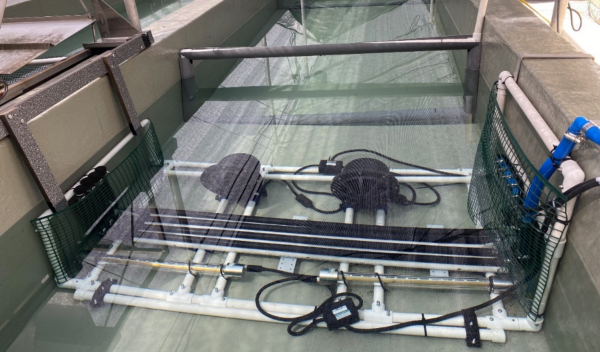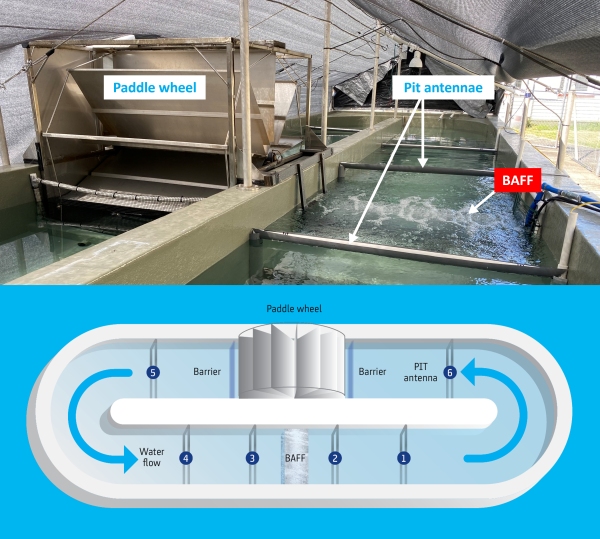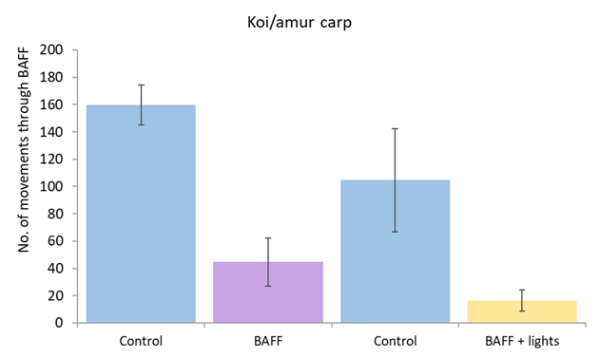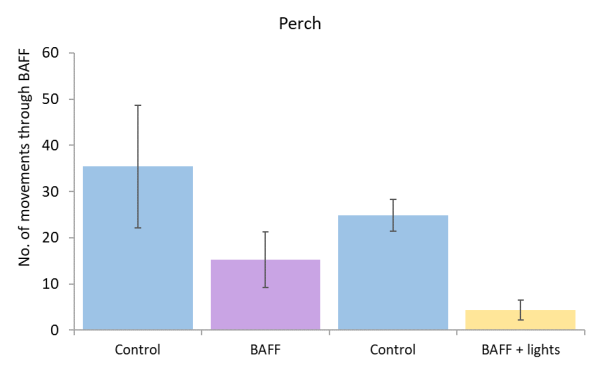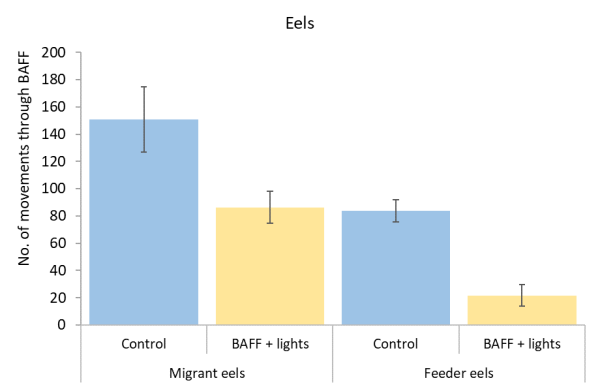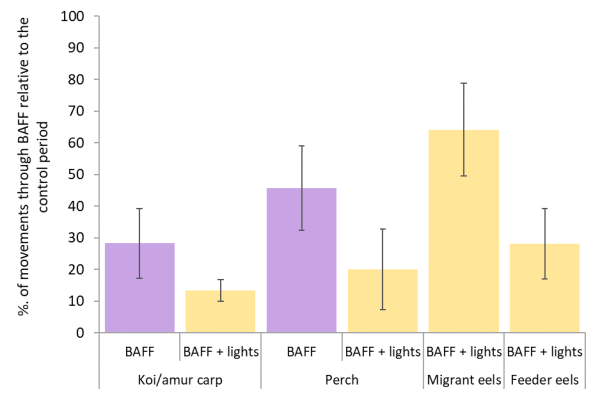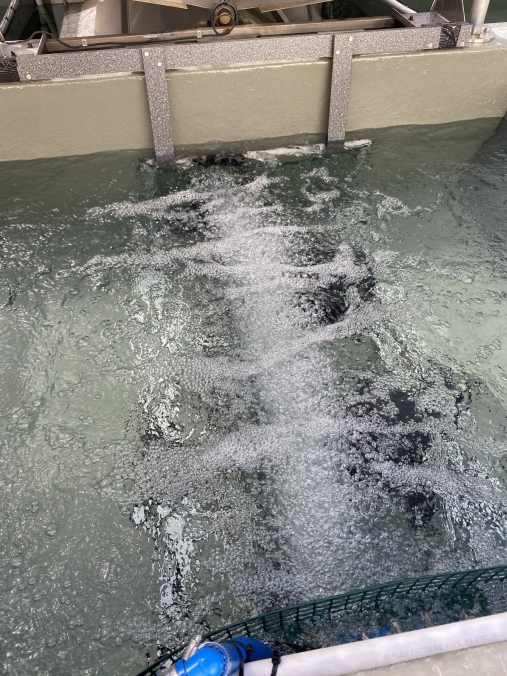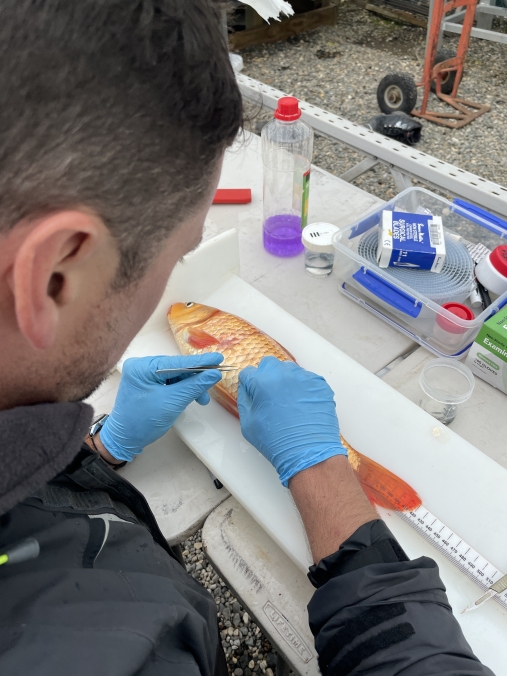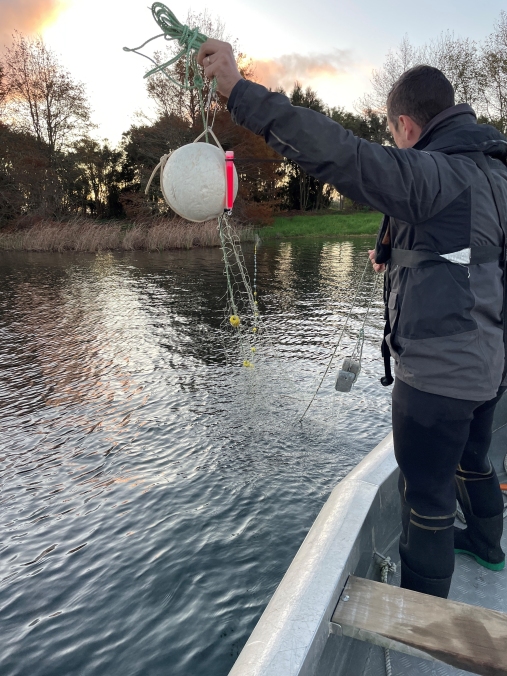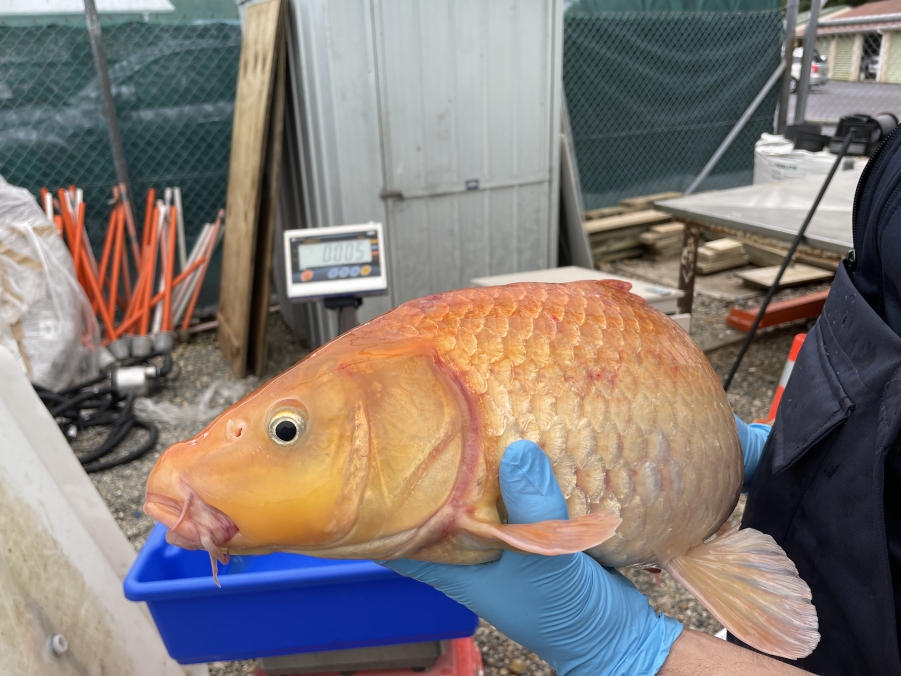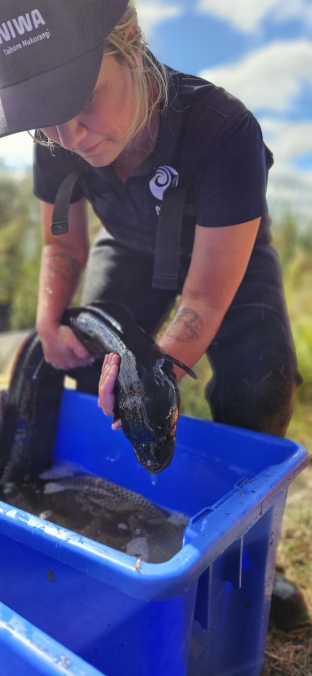Pest fish species are a leading threat to global biodiversity, are economically costly, and cause ecological damage. Management of pest fish is currently limited to preventing their spread, focusing largely on physical removal or poison (piscides), but these methods are not effective in all situations, or cost effective. We are investigating the effectiveness of an acoustic bubble-screen in minimising the movement of pest fish.
What is a BAFF?
The Bio-Acoustic Fish Fence (BAFF) is in essence a system of tubing along the bottom of a lake or river which uses compressed air to produce a screen of bubbles. Linked to this system is a series of underwater speakers that produce cyclic sound bursts between 20 and 2000 Hz and acts as a behavioural deterrent to certain fish species. This system can also be coupled with a series of strobe lights which act as a further deterrent.
Laboratory studies by have shown that the BAFF was effective in blocking 97% of bighead carp (Hypophthalmichthys nobilis). Another 2023 study showed the BAFF blocked four carp species (Silver carp, H. molitrix, bighead carp, common carp, Cyprinus carpio and grass carp Ctenopharyngodon idella) between 92-97% of the time without habituation.
Our research project
NIWA has been investigating the effects of the BAFF alone, as well as coupled with strobe lights, on three exotic fish species, perch (Perca fluviatilis), koi/amur carp (Cyprinus rubrofuscus) and brown bullhead catfish (Ameiurus nebulosus). To ensure this system doesn’t negatively impact the movements of native desirable fish species, longfin eels and shortfin eels have also been tested.
If the BAFF is effective at blocking the movements of undesirable fish species, such as koi/amur carp, it can be used to prevent movements of carp to their preferred spawning grounds and disrupt reproduction. Other uses may include restricting movement into areas where pest fish are not currently present or in low abundance, and guiding fish to traps.
Study design
The BAFF was set up in the centre of an elliptical flume at NIWA’s Ruakura research facility. A paddle wheel was used to generate a low flow with a water velocity of 0.2 m s-1 and Passive Integrated Transponder (PIT) antennae were set in six locations of the flume (Figure 1). All test fish had PIT tags surgically inserted into their abdominal cavity. These PIT tags are detectable by the PIT antenna in the trial flume which allowed mapping of each fish’s movements through the BAFF during control and trial periods.
For each species 10 fish were placed in the flume and given a one-hour acclimation period. Half the fish were placed upstream of the paddle wheel and half downstream. Fish were confined to the release area by an additional removable barrier, which was removed at the conclusion of the acclimation period. After the acclimation period, fish movements were monitored using the PIT system for a ten-minute control period, followed by a ten-minute trial period during which the BAFF was active. A ten-minute recovery period followed the BAFF before another trial period occurred. The control-BAFF-recovery cycle was presented to fish eight times during the four-hour trial.
Exotic fish
For all exotic fish, five trials were carried out with the BAFF alone and five trials with the BAFF paired with strobe lights. Koi/amur carp and catfish were tested during daylight hours. Perch were tested at dusk due to their heightened crepuscular activity. All exotic fish were euthanised and sexed at the conclusion of the trial.
Eels
For eels both feeder eels and migrant eels were tested. Most eels captured were shortfin eels (Anguilla australis), however, some longfin eels (A. dieffenbachii) were included and tested together as “eels”. Migrant eels have a strong urge to travel downstream and were not expected to travel back and forth around the flume like the other trial fish. For this reason, the trial methods were changed to replicate what eels would experience in the field.
All trials were carried out in the evening from 7pm to midnight. Between 7 and 10 eels were used per trial. For each trial, all eels were placed on the upstream side of the paddle wheel and confined in that area by the removable barrier for the one-hour acclimation period. After which, the eels were released, and subjected to the BAFF and strobe lights for a two-hour trial period. After two hours, the system was turned off and eel movements were monitored for a further two-hour control period.
In total, six trials were carried out with migrant eels and three trials with feeder eels. The same trial methodology was used for each eel life stage. Due to constraints on timing, feeder and migrant eels were only tested with the BAFF and strobe lights presented together, the BAFF in isolation was unable to be trialled. All eels were returned to the place of capture after trials concluded.
Study results
Exotic fish
Koi/amur carp: Trials to date have indicated that koi/amur carp exhibit a strong avoidance towards the BAFF and BAFF paired with lights (Figure 2).
Significantly less movements by koi/amur carp were made through the BAFF with lights compared to control trials (P=0.015; Mann Whiney U test), with results comparable to that achieved in the United States.
Perch have also exhibited an avoidance towards the BAFF, which was statistically significant when paired with strobe lights (P=0.004; Mann Whiney U test; Figure 3)
When movements through the BAFF were examined relative to the control trials, koi/amur carp exhibited a stronger avoidance towards the BAFF and BAFF paired with lights compared to perch. However, an 80% reduction in movements of perch when the BAFF is paired with lights, will likely be useful for deterring perch from areas when deployed in the field.
Catfish did not display a strong avoidance of the BAFF and it is unlikely to have any impact on this species where deployed.
Eels
Both migrant and feeding adult eels showed an avoidance towards the BAFF paired with strobe lights (Figure 4). No avoidance was found to be statistically significant, which is likely due to the small sample sizes. The reduction in movement was higher in feeding eels than observed with migrant eels (Figure 4). Time constraints prevented testing both migrating and feeding eels to the BAFF without lights.
Overview
What does this mean?
Exotic fish
Data from the BAFF trials to date, indicate that the BAFF paired with strobe lights is a significant deterrent to koi/amur carp and perch movements. The significant increase in avoidance seen in perch when the BAFF was paired with lights, indicates the strobe lights were the key deterrent for this species.
Many lakes and waterways where invasive fish are problematic are highly turbid due to the bioturbation associated with the feeding style of species such as koi/amur carp alongside other stressors. Given the increased avoidance of both koi/amur carp and perch towards the BAFF when it was paired with strobe lights, turbidity levels of potential deployment sites could affect the performance of the BAFF system.
Catfish did not display a strong avoidance of the BAFF and it is unlikely to have any impact on this species where deployed.
Eels
Migrant and feeder eels also avoided the BAFF and lights when operating. The reduction in movements observed in eels was not as high as for koi/amur carp, however, as a taonga species, uninhibited movements of eels through the BAFF is desired. Based on their biology and international studies on behavioural guidance devices, it is likely that the strobe lights and sound could both be acting as a deterrent for eels. A range of behavioural technologies (e.g., light, sound, water jets, bubble curtains, electric fields) have been reviewed for their effectiveness on influencing the behaviour of downstream migrating eels (see references). The review concluded that light and infrasound (< 100 Hz) were the main stimuli to demonstrate some level of deterrent in downstream migrant eels. As the BAFF produces cyclic sound between 20 Hz and 2000 Hz, it encompasses the infrasound frequencies shown to cause changes in eel behaviours.
Next steps
- Continue testing eels to determine the key driver of their avoidance behavior between the BAFF and strobe lights.
- Investigate the effects of suspended sediment on the response of eels, koi/amur carp and perch towards the BAFF paired with strobe lights.
Download:
Acknowledgements
We thank Fish Guidance Systems for supplying the BAFF equipment and set up advice. We wish to thank Tawera Nikau (Te Riu o Waikato), James Manukau, Nicholas Manukau & Koroki Waikai (Waikato Tainui) and Nick Ling (University of Waikato) for helping with fish collection. We also wish to thank NIWA staff Rebecca Booth-Green, Michele Melchior and Rachel Crawford for assistance with fish tagging and carrying out the trials.
This NIWA Freshwater Biosecurity programme research was funded by the Ministry for Business, Innovation and Employment Strategic Science Investment Fund.
References
Dennis. C.E., Zielinski, D., Sorensen, P.W. (2019) A complex sound coupled with an air curtain blocks invasive carp passage without habituation in a laboratory flume. Biol Invas 21:2837-2855
Freely, J.R., Sorensen, P.W. (2023) Effects of an ensonified bubble curtain and a cyclic sound on blocking 10 species of fishes including 4 invasive carps in a laboratory fume. Biol Invas https://doi.org/10.1007/s10530-023-03022-6
Richkus, W.A., Dixon, D.A. (2003). Review of research and technologies on passage and protection of downstream migrating catadromous eels at hydroelectric facilities. In ‘Biology, Management and Protection of Catadromous Eels’. (Ed. D. A. Dixon.) pp. 377–388. (American Fisheries Society: Bethesda, MD.)

